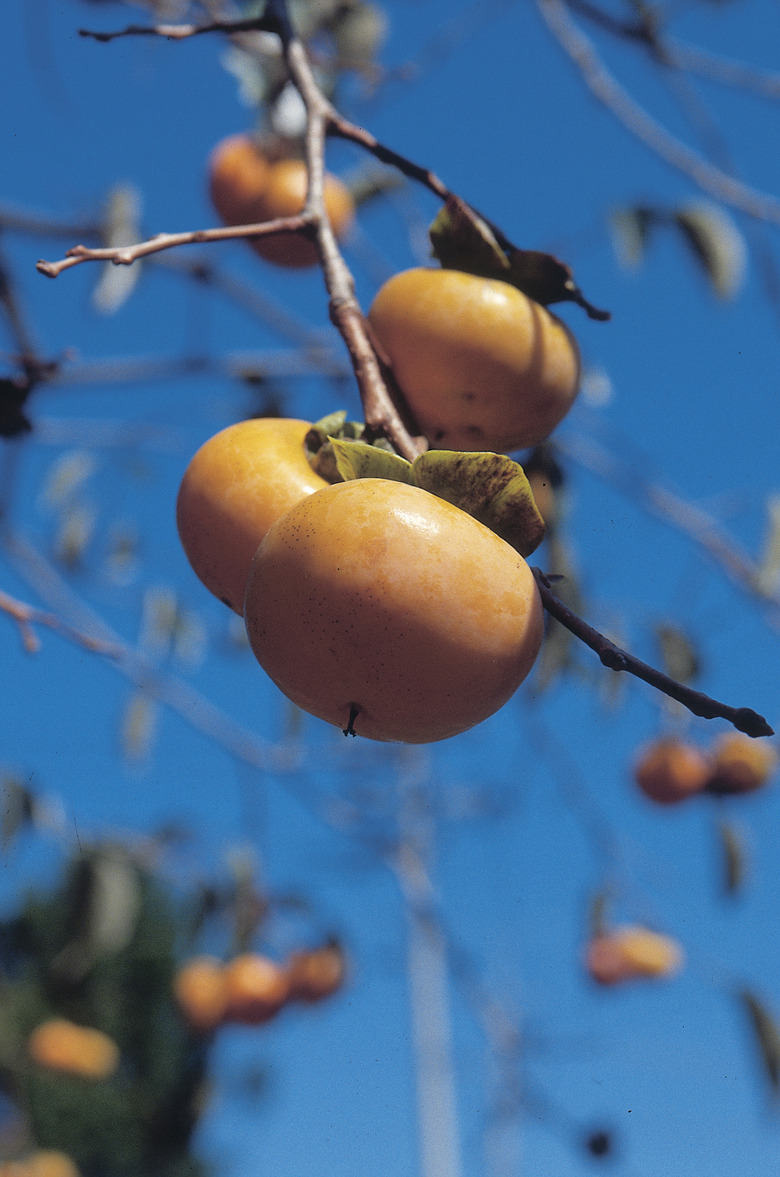How To Grow Persimmons From Seed
Whether you grow persimmon (Diospyros spp.) for its aesthetic value or for its fruit, the tree won't disappoint. With its yellow-orange to orange-red fruit, its pink or cream-colored flowers and its glossy green foliage that turns red, orange or yellow in the fall, this member of the Ebenaceae family is hardy to U.S. Department of Agriculture plant hardiness zones 7 through 10. Although starting persimmon from a nursery-bought grafted specimen is possible, growing it from a seed is economical and can be just as rewarding.
Step 1
Step 1
Place the persimmon seeds in a plastic sandwich bag or glass jar with an equal amount of moist sand or peat. Store the bag or jar in the refrigerator for three months. This cold-treatment is known as stratification and breaks the seed's dormancy, which can inhibit germination. Start it late in the fall or early in the winter, about five months before the last spring frost. Throughout the three months, periodically check the medium, and spray it with a water-filled bottle so it stays moist the entire time.
- Whether you grow persimmon (Diospyros spp.)
- Throughout the three months, periodically check the medium, and spray it with a water-filled bottle so it stays moist the entire time.
Step 2
Step 2
Put peat pellets in a tray or cake pan that's filled with 1 inch of water and allow the pellets to soak up the moisture and expand. Discard any water that's left over, and then press one persimmon seed in each pellet to a depth of 1 inch. Place the tray in a clear, plastic bag to create a humid environment. The seeds germinate in two to three weeks in dark or light conditions in a temperature range of 68 to 86 degrees Fahrenheit.
Step 3
Step 3
Remove the plastic bag as soon as the seeds germinate. Place the tray with the peat pellets in a sunny, south-facing window so the seedlings can grow. The ideal temperature during this phase is 65 to 70 degrees Fahrenheit during the day and 55 to 60 degrees Fahrenheit at night. Periodically rotate the tray so the seedlings grow upright and don't have to reach for the light. Alternatively, suspend two, 40-watt fluorescent lamps about 6 inches above the seedlings and keep the lamps on for 16 hours a day. As the seedlings grow, move the lamps up so they always remain at least 6 inches above the young plants.
- Put peat pellets in a tray or cake pan that's filled with 1 inch of water and allow the pellets to soak up the moisture and expand.
- Place the tray with the peat pellets in a sunny, south-facing window so the seedlings can grow.
Step 4
Step 4
Fill 4-inch pots up to one-third of the way with moist potting mix when the seedlings are 3 inches tall. Place a peat pellet with a seedling in the center of each pot and continue filling the remaining two-thirds of the pot with moist potting mix. Keep the soil moist as the seedling grows.
Step 5
Step 5
Harden off the young persimmon plants over a two-week period before transplanting them in the garden after the last spring frost. Place the pots in a sheltered area outside for two hours a day and gradually extend the duration that you leave them outside so they can slowly acclimate to the outdoor environment.
Step 6
Step 6
Transplant the young persimmon plants to a sunny area of the garden with well-drained soil. Plant the trees at a similar depth they were previously growing and space multiple trees 20 feet apart in each direction.
- Fill 4-inch pots up to one-third of the way with moist potting mix when the seedlings are 3 inches tall.
- Place a peat pellet with a seedling in the center of each pot and continue filling the remaining two-thirds of the pot with moist potting mix.
Tip
Obtain persimmon seeds from garden centers, seed catalogs or extract them from the ripe fruit.
Things Needed
- Sandwich bag or glass jar
- Sand or peat
- Spray bottle
- Peat pellets
- Tray or cake pan
- Clear plastic bag
- 40-watt fluorescent lamps
- 4-inch pots
- Potting mix
References
- California Rare Fruit Growers: Persimmon
- Native Trees, Shrubs, & Vines; William Cullina
- North Carolina State University: Department of Horticultural Science: Overcoming Seed Dormancy: Trees and Shrubs
- Don't Throw It, Grow It!; Deborah Peterson
- North Carolina State University: Department of Horticultural Science: Starting Plants from Seeds
- Purdue University Cooperative Extension Service: Persimmons
- Journal of Range Management: Germination of Texas Persimmon Seed
